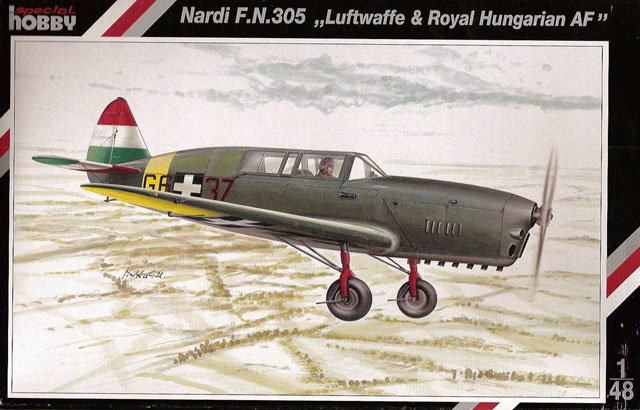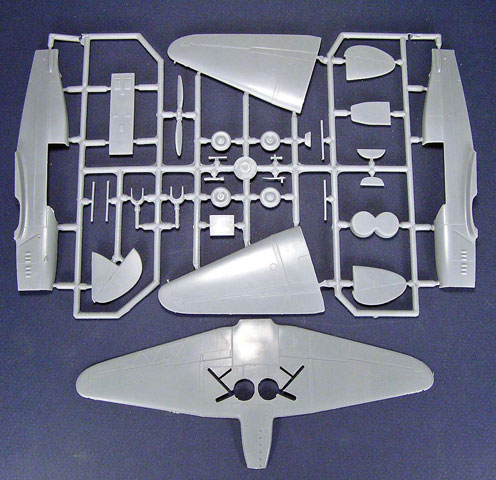|
Nardi F.N. 305

MPM
S
u m m a r y
|
| Catalogue Number: |
SH48019 - Nardi F.N. 305 |
| Scale: |
1/48 |
| Contents and Media: |
31 parts in grey
styrene, 2 parts in vac-form canopies, 3 pieces in cream colored resin,
15 etched metal piece and printed film for the instrument panels.
Markings for two aircraft. |
| Price: |
USD$26.96 on line from Squadron.com |
| Review Type: |
FirstLook - In Box |
| Advantages: |
A unique
offering of a relatively little known aircraft. |
| Disadvantages: |
Slightly blue
tint to the clear parts. |
| Recommendation: |
Recommended |
Reviewed by Steven "Modeldad" Eisenman

Special Hobby's 1/48 scale Nardi F.N. 305
may be ordered online from Squadron
Who said model companies don’t pay attention to
modelers’ lists of aircraft?
There is no question about it. The Nardi F. N. 305
must be on more modelers' lists of aircraft that they know virtually
nothing about, or the list of aircraft that no modeler would ever expect
to be produced in 1/48 scale (or any scale for that matter).
Well the people at Special Hobby listened, paid
attention and responded with a new limited run model of this two-place
trainer. Truth be told, after doing some research it appears that there
have been quite a few models, in both 1/72 and 1/48, of the Nardi 305.
It has been issued in 1/72 by Legato, Azur, and Djinn and in 1/48 by
Italian Kits and LF Models.
The Nardi, one of Italy’s first aircraft with
retractable landing gear, was the product of two enterprising, young
aircraft designers. The prototype was produced in 1929 by
Società Nardi (Fratelli
Nardi). But, it was not until 1937 that the Regia Aeronautica
accepted the Nardi’s design as a basic trainer. However, most were
produced by Piaggio, as the Nardi’s production facility was inadequate.
Over 400 Nardis were built and were used by the RA,
and also sold to France, Hungary, Chile and Rumania (Rumanian Aircraft
Industries “IAR” built another 124 under license.). The Luftwaffe
acquired its Nardis from the French. It also appears that the Nardi
came in a few styles: a single seat model and an open canopy model and,
apparently, there were two styles of fuselage, one with a narrower
spine.
To be quite honest, the Special Hobby Nardi 305 is
a very basic kit of a very basic aircraft. This is not really a
criticism, as the few pictures I’ve seen of the Nardi show a cockpit
that is nothing more than a seat, instrument panel and stick, and such
is the cockpit of this kit. There is virtually no detail on the
sidewalls or floor. The seats, molded in cream colored resin, have the
lap and shoulder belts molded on. But, they do not look like the
typical “bondage” style seat belts that we have come to expect in
Italian aircraft, such as used in the the Macchi. Because of lack of
information, I cannot say if they are correct or not.

Click
the thumbnails below to view larger images:
The engraved panel lines are cleanly done. But,
there are also raised lines. These are on the control surfaces and
presumably represent the seams in the fabric.
It is hard to tell from the few pictures I have
seen, but a modeler may want to slightly extent the exhausts, on the
underside of the cowl, by making small stubs out of fine tube or rod
stock. Also, it appears that some Nardis, such as those used by the
Chilean Air force, did not have the vents on the sides of the cowl.
As in Special Hobby’s Macchi 200 1 Serie, the clear
vac-f1ormed canopy has a distinct blue tint to it. This is a relatively
new issue in Special Hobby kits. It could be merely a bad batch of
clear stock.
Markings:
The markings are a bit of a disappointment, as far
as I’m concerned anyway, as they are a bit dull. It is a shame that
Special Hobby did not offer the markings for the Nardi 305 two-seater
that took part in the 4th International Littorio Air Rally of
1939. There is a picture of this aircraft in Wings of Italy (OOP), it
is all red with the green, white and red vertical stripes on the fin and
rudder and a black lightening bolt down the side wit the number “33”.

The markings that are included with the kit
are for two aircraft, both of which are in Dark Green on the upper
surfaces with Light Gray under surfaces.
-
Luftwaffe Pilot
Training School FFS(A) 14, Klagenfurt, 1944.
-
Hungarian Air Force
Pilot Training School, Regvi Szombathely, 1942 – The Hungarian
tri-color of red white and green is to be painted on the fin and
rudder and on the tail planes.
One note on painting - it is most likely that Nardi
painted the wheel struts red. This could have been done to make the
lowered gear more visible, as viewed from the ground. The instructions
do indicate that they should be painted this color.
As for the specific color of various parts, the
only model paint referenced is Gunze, and then only by number. To help
with your build, here are the paint call-outs for Gunze:
-
H8 – Silver
-
H12 – Flat Black
-
H13 – Red
-
H17 – Cocoa Brown
-
H28 – Metal Black
-
H33 – Russet
-
H77 – Tire Black
-
H79 – Sandy Yellow
-
H312 – Green (FS 34227)
For anyone wanting to do a limited run kit, this
may be the ultimate “starter” kit. No giant resin pour stubs to fight, a
little bit of etched metal and mostly injection plastic.
Is this kit accurate? I have no idea on the
dimensions, but it does look very much like the Nardis in the few
pictures I have seen. If nothing else, this kit looks like a nice
little bit of diversion from one’s regular diet of Spitfires, 109s and
P-51s.
Web
sites:
http://www.paulnann.com/images/pn_w4953.jpg
http://www.paulnann.com/images/pn_w3742.jpg
http://web.tiscali.it/warbirds/warbirds/fn305.htm
http://www.fach-extraoficial.com/espanol/nardi.htm
http://users.belgacom.net/aircraft1/avion1/243.html
Recommended.
Thanks to MPM / Special Hobby for the
review sample.
MPM
kits are available worldwide through hobby retailers
worldwide
Review and Images Copyright © 2004 by
Steven Eisenman
Page Created 28 April, 2005
Last updated 27 April, 2005
Back to HyperScale Main Page
Back to Reviews Page
|
Home | What's
New | Features
| Gallery |
Reviews | Reference
| Forum
| Search